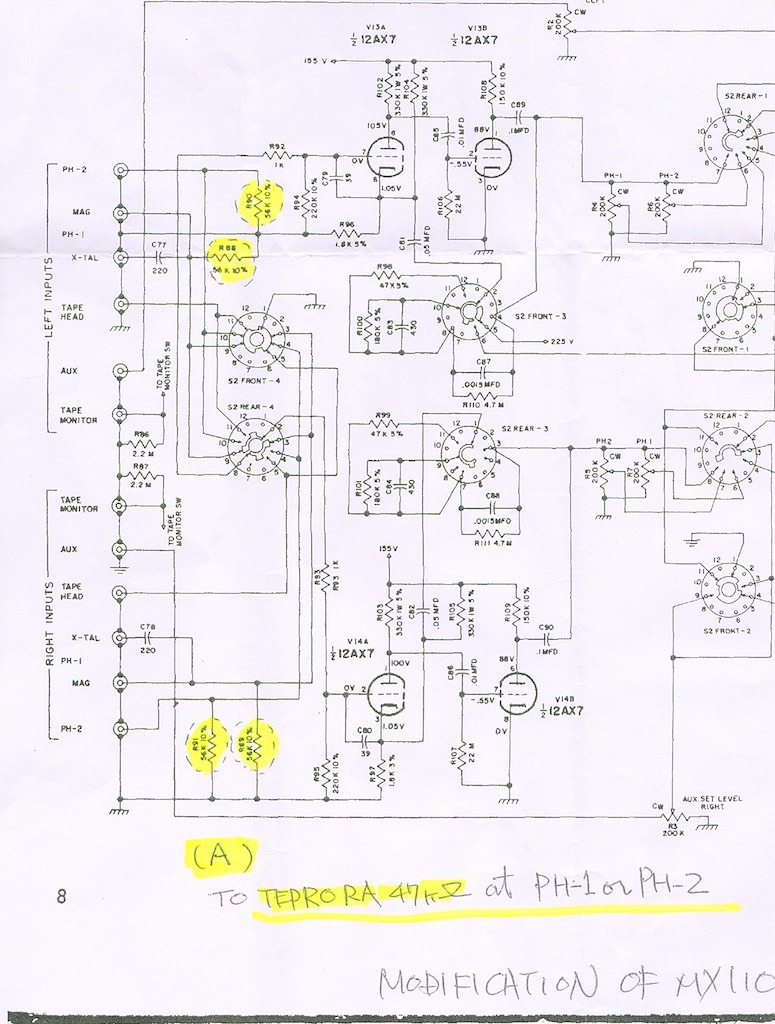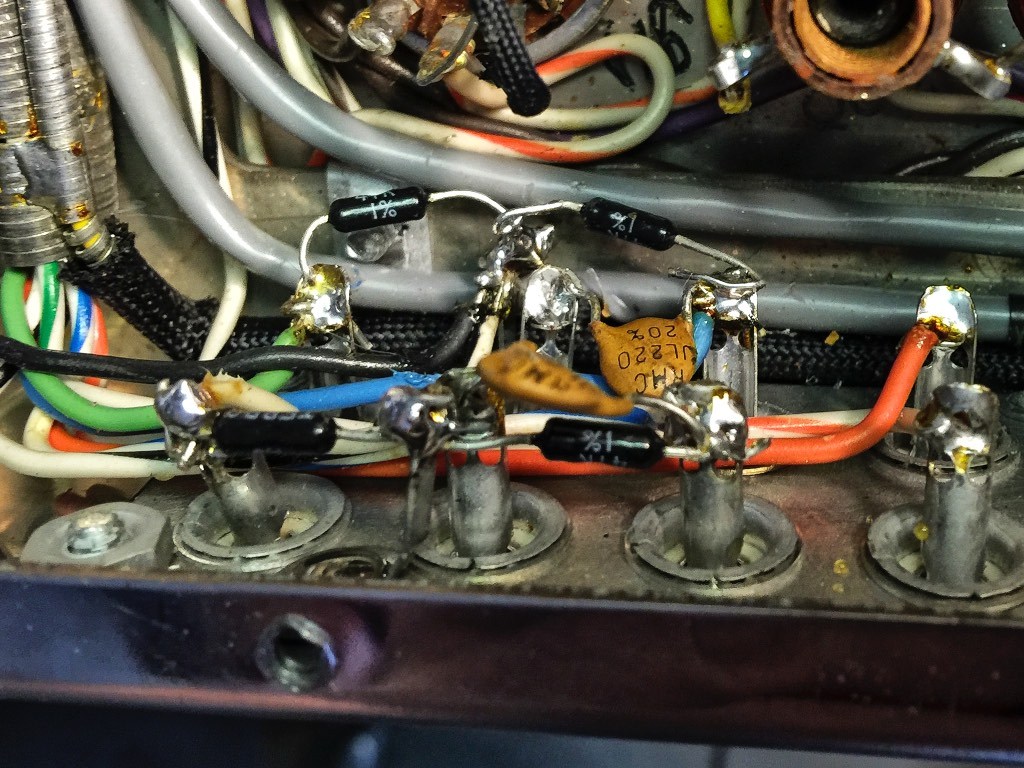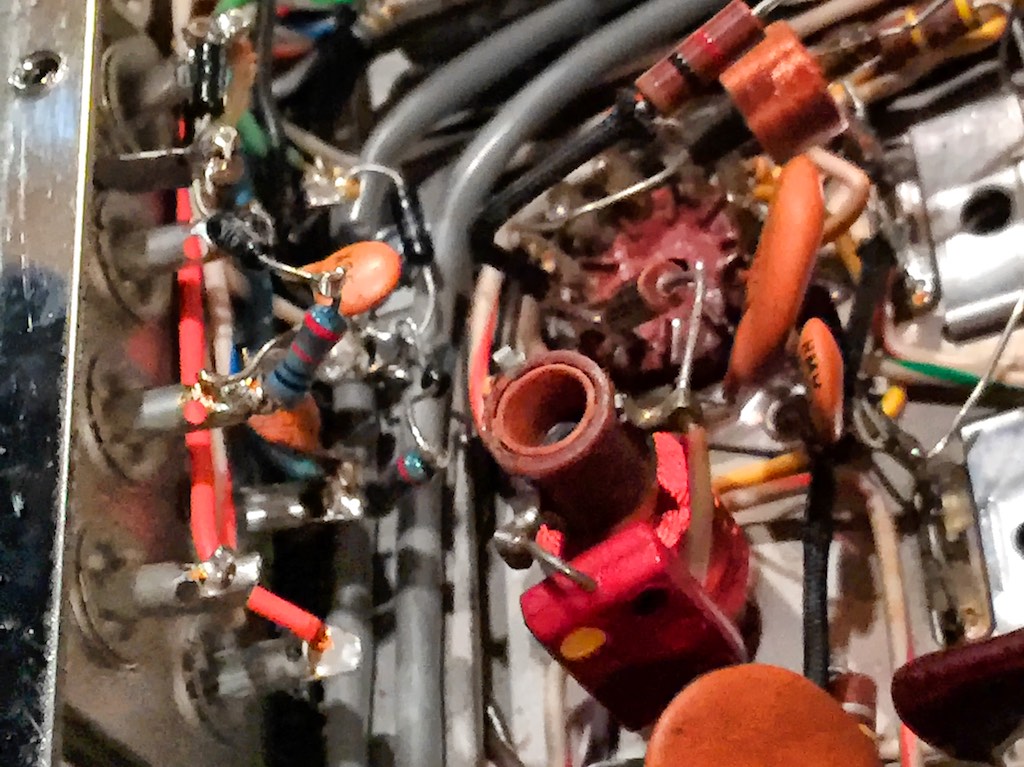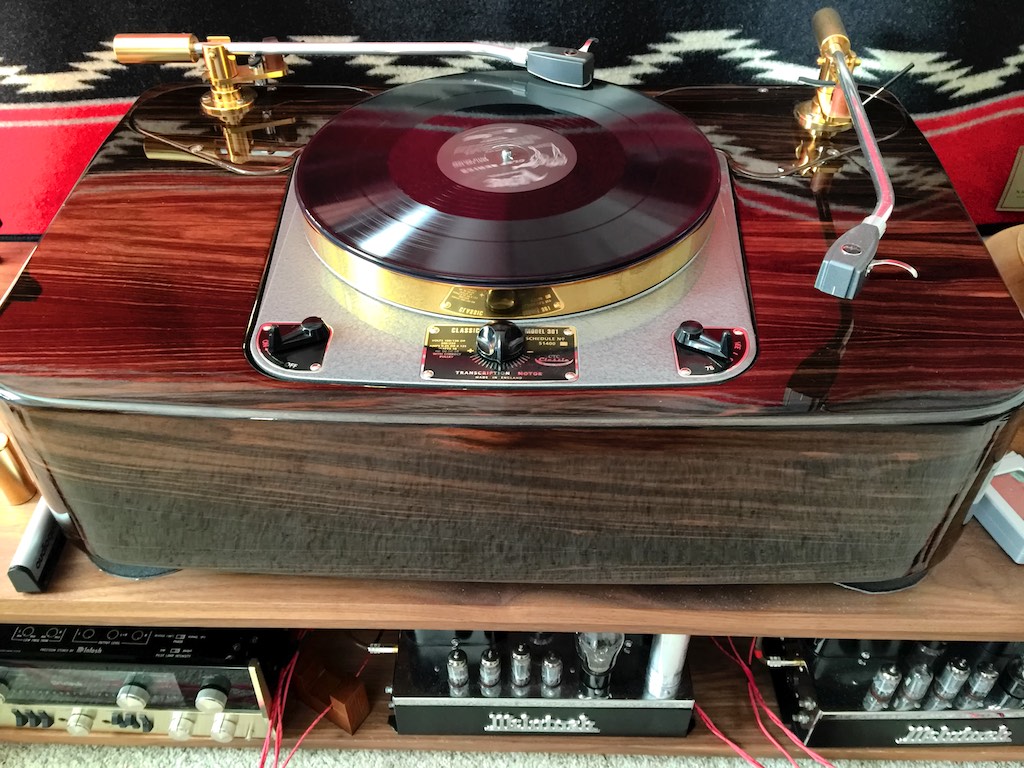If you've been reading along about our real sound adventures with my vintage McIntosh MX110Z tuner-preamplifier, you know the modifications we did threw us a curve ball, and the resulting performance after our modifications didn't sound nearly as good as my stock MX110Z. Argh!
While there were some promising aspects to the performance of my modified MX110Z, we basically struck out, and we needed to rewind to the beginning and rethink each modification, then figure out how to optimize each modification until the result was that my modified MX110Z's performance exceeded that of the stock version.
I realize now that it's no easy task to improve upon the performance of a stock MX110Z, and I have new found respect for the terrific job McIntosh did on voicing the MX110Zs back in the day.
The first step was to revisit Modification A, where we replaced the 56KΩ phono input resistors at R88 & R90 and R89 & R91 for phono inputs 1 & 2, as it is these resisters that are mainly responsible for the phono stage’s ultimate sound quality.
There's two things that turned out to be very important for Modification A, the first being the amount of resistance (56K Ohm vs. 47K Ohm), and (perhaps) the type of resistor used (metal film, carbon comp, etc.).
We had dropped the resistors for the phono inputs from 56K Ohm to 47K Ohm by inserting 47K Ohm Tepro RA resistors for the stock resistors (more about the stock resistors in a moment), which had turned out to be a sonic disaster, with the highs becoming shrill and unlistenable.
Before we changed out the Tepro RA phono input resistors, Yazaki-san recommend we first try changing out the stock 220kΩ Allen Bradley resistors located at R94 & R95, for 1MΩ resistors, to see if that had a beneficial effect.
Yazaki-san's reasoning was, “I checked the circuit diagram of the first stage of phono EQ of Marantz Model 7 and also McIntosh C22. They use the phono input resistor, 47kΩ and the grid resistor, 1MΩ for 12AX7. And the combined resistance is around 44.9kΩ. But MX110, the phono input resistor, 56kΩ and grid resistor, 220kΩ. And also the resistance is 44.6kΩ. When we installed 47kΩ into MX110, the combined resistance is 38.7kΩ. I suppose you have been using MC transformer and the combination of your MC transformer and the input resistor, 47kΩ would be some harmful effect on the tonal character. And so, I have a idea that, how would be changing the resistor R94 & R95 from 220kΩ to 1MΩ … And I suppose there would not be any negative effects about this changing.”
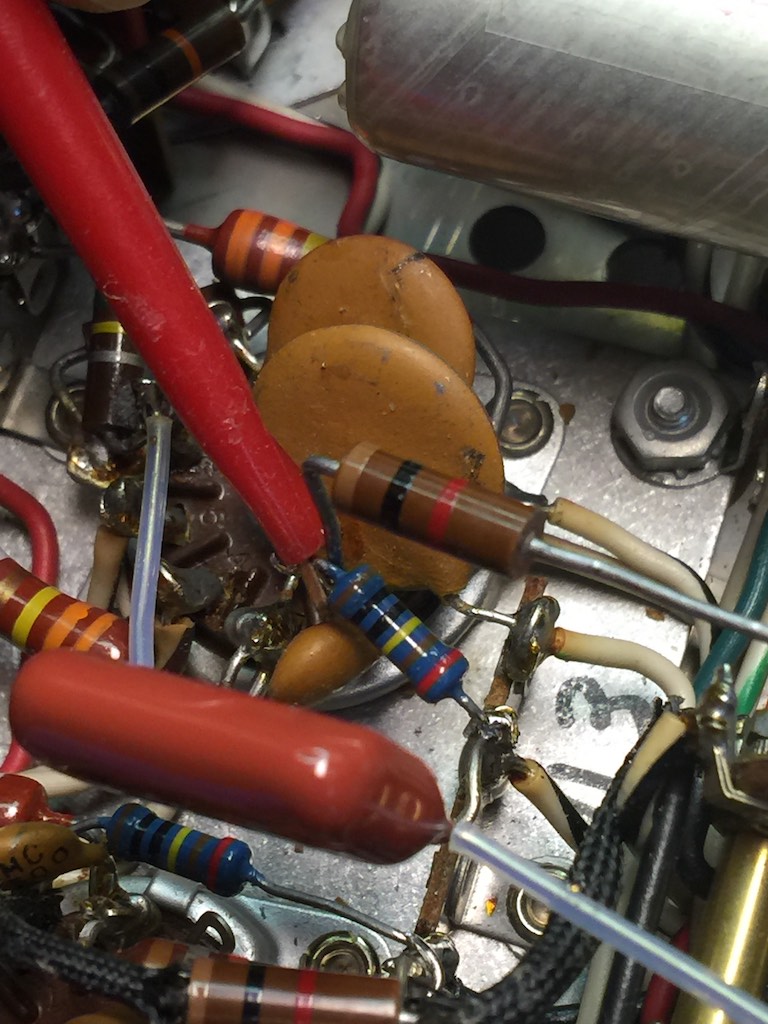
Here you can see the blue 1M Ohm Roederstein resistors that Ron used to replace the stock Allen Bradley 220K Ohm resistors at R94 & R95.
There was some small improvement by going to the Roederstein 1MΩ resistors at R94 & R95, but unfortunately my MX110 was still essentially unlistenable. The change we made at R94 & R95 probably warrants further investigation in the future, by either going back to Allen Bradley 220K Ohm resistors (stock), or trying 1M Ohm Allen Bradley resistors in place of the Roedersteins 1M Ohm resistors, which is what I'm leaning towards given the improvement we heard going to 1M Ohm resistors.
To get an idea of how big the role the 47K Ohm input resistance value was in our sonic ills (or something else), Ron soldered NOS ¼ watt 9KΩ Roederstein resistors in series with the Tepro RA 47KΩ resistors on phono input 1 (photo below), bringing the total resistance on input 1 back to 56KΩ, while leaving phono input 2 at 47KΩ as a control.
Going back to 56KΩ input resistance resulted in significantly better performance, so clearly the MX110's circuit is very sensitive to the resistance used on the phono inputs. While there was a significant improvement by going back to 56KΩ input resistance, there was still some edginess in the region of female voice (and brass) that was not present in my stock MX110, and overall the modifications resulted in musical quality that was not as good as it was before we modified it, even though in some aspects there were improvements in sound quality.
In my last post I reported that I had installed a pair of NOS Allen Bradley 56K Ohm 2W carbon comp resistors in place of the 47K Ohm Tepro RA metal film resistors on phono input 2, and the improvement was a big step in the right direction compared to the Tepro & Roederstein combination on phono input 1, but it was apparent we still had a ways to go.
Interesting tidbit: Ron pointed out to me after I bought the Allen Bradley 56K Ohm 2W carbon comp resistors, that Allen Bradley resistors were the OEM resistors McIntosh used back during this period (albeit lower wattage versions on the phono inputs), which partly explains the voicing and excellent sound of a stock MX110Z.
This week I received the NOS 56K Ohm 1/2 watt Shinkoh tantalum resistors (as used on the original Kondo Ongaku amplifier), and the 56K Ohm Vishay VAR-Series ”naked ladies” metal foil 'z-foil' resistors, that I wanted to try as part of our phono input resister adventure. I also received some NOS 47K Ohm 2W Allen Bradley resistors that I had ordered (more about those in a moment).
Ron and I discussed our resistor adventure strategy for Modification A, and we decided on the following path forward:

You can see the tiny 56K Ohm Vishay VAR-Series ”naked ladies” z-foil resistors just to the left of the rather gigantic (by comparison) Allen Bradley 56K 2W resistors.
First we would install the 56K Ohm Vishay VAR-Series ”naked ladies” z-foil resistors on phono input 1 of my MX110 in place of the Tepro & Roederstein combination (above), so we could then compare them to the Allen Bradley 56K Ohm 2W carbon comp resistors on phono input 2.

Below and to the right of the 0.22uF Red Cactus caps you can see the 47K Ohm Allen Bradley resistors that replaced the Tepros at R116/R117.
Secondly, we would revise Modification C where we replaced the R116/R117 with the Tepro RA 47KΩ resistors, and changeR116/R117 back to the stock 47KΩ Allen Bradley resistors (albeit 2 watt versions), to remove that as a variable (above).
Thirdly, we would reverse the directionality of one of the 0.22uF Red Cactus Arizona Capacitors in Modification B based on Yazaki-san's recommendation. Yazaki-san told us that the printed cactus on Arizona Capacitors cap's indicates the outer foil and that end is intended to be attached to the lower potential point (like ground) in the connection for the best sound. We had one of the 0.22uF Arizona Capacitors the other way around so we reversed it (also in the photo above).
My buddy Leo loaned me his vintage McIntosh C22 to listen to (Thanks Leo!) while Ron was installing the modifications into my MX110, and it was illuminating, as it took me back to the sound of of my unmodified MX110 as a reference (or pretty close to it, as the C22 and MX110 phono sections are similar, but not identical sounding).
As you might imagine, the stock C22 bested the performance of my modified MX110 that Ron was working on, bringing back that easy musicality I had become used to with my vintage MX110, and for the first time in a while I was able to relax into the music and enjoy my time listening.
After Ron finished up implementing the trio of updates in my MX110 he stopped by for a listening session. First we listened to Leo's vintage McIntosh C22 preamplifier, and we were both all smiles.
Then we installed my MX110 into the system with its 56K Ohm Allen Bradley resistors on PH2, its new 56K Ohm Vishay ”naked ladies” dancing on PH1, the 47K Ohm Allen Bradley resistors that replaced the Tepros at R116/R117, and the newly aligned 0.22uF Red Cactus cap in Modification B.
Together, those component alterations resulted in a rather enormous change for the positive, with my modified MX110 now outperforming my stock MX110 in most aspects, but not quite all. We are getting very, very, close to hitting a real sound home run!
So, for example, PH2 (with the Allen Bradley 56K Ohm resistors) produced a much more resolving & transparent sound than my stock MX110, with more presence & body to images, and a much greater sense of space that filled the room. The soundstage also expanded in width & depth, with a sense of ambience that was really impressive. The sound of the modded MX110 on PH2 was somewhat darker & richer than my stock MX110, and I'm still trying to decide if I like that better or not. It's a very beautiful presentation, but it may be just a tad too dark & rich, but then again maybe not, so more listening is in order. The timbral textures are very good, as is tone color. Macro-dynamic ability has increased, and bass resolution & impact has increased. The presentation of vocals and brass (especially muted trumpet) was greatly improved, and at least on well recorded material, the performance was now in the acceptable range. I do think the presentation can be improved further on vocals & brass, and at the same time bring more of the musicality out for those less than well recorded albums.
As an aid to keeping things straight, I run my Ortofon SPU Classic GM MkII stereo phono cartridge in PH2, and my Ortofon SPU Mono CG 25 Di MkII into PH1.
The new 56K Ohm Vishay "naked ladies" are installed on PH1 that I use for mono, so Ron and a played a series of excellent mono recordings to see how things fared musically with "naked ladies" dancing on PH1.
The short answer is that the Vishay "naked ladies" sounded really, really, good on PH1, and perhaps even better than the Allen Bradley's on PH2, but I don't know that for sure yet, as the stereo & mono Ortofon SPUs sound a bit different (with the mono SPU sounding a bit smoother, sweeter, and more natural than its stereo brother does).
I've run out of time, but the next step is to put in some more listening time in on the MX110, listen to both PH1 & PH2 with both the stereo & mono SPUs, and make some assessments about the overall sound quality of the the Allen Bradley's compared to the Vishay "naked ladies".
Well, I'm starting to breathe a sigh of relief that the real sound adventure with my MX110 is starting to perform better, and I'll look forward to telling you more about the results soon!
Thanks for stopping by!





